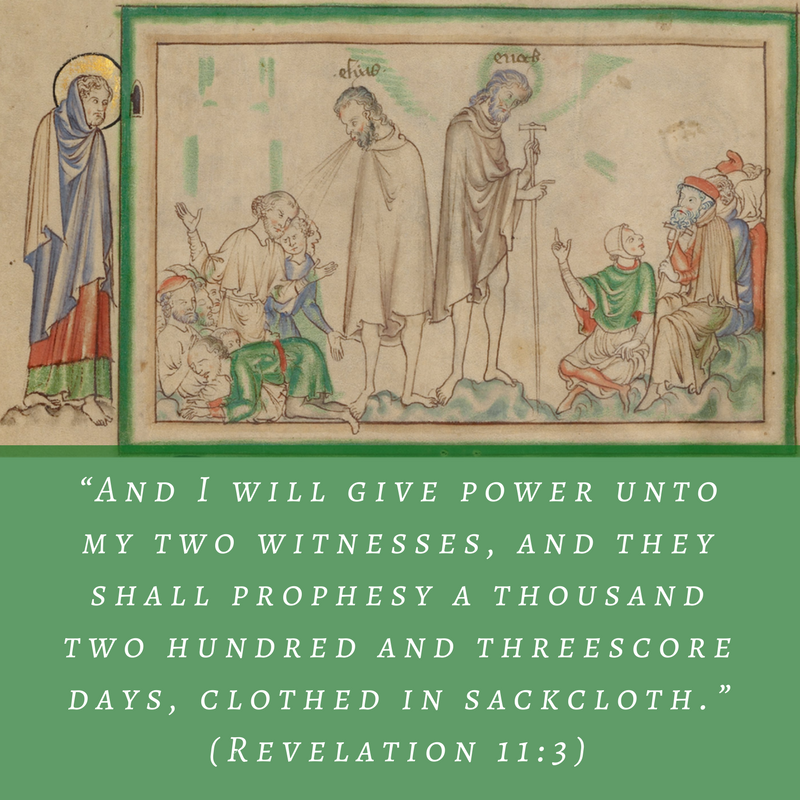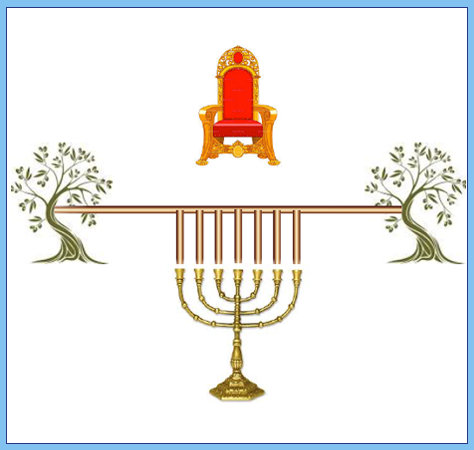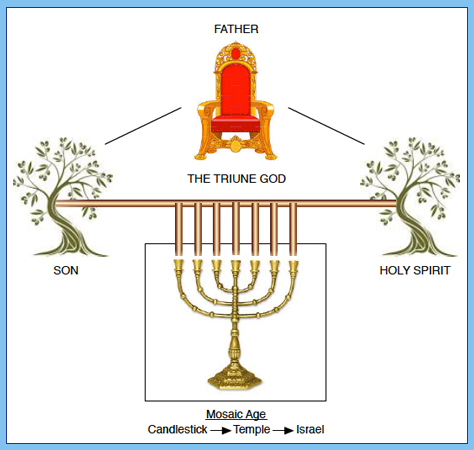
One proof of a good theory is its ability to suggest answers to difficult problems. We have seen how our prophetic model—inmillennialism—does this in Hebrews.1 We are now applying this framework to John’s visions in Revelation.
The complications increase here due to the many prophetic images in this book, but, to this point, the model has served us well. Already in Revelation, we have seen a mountain cast into the sea, a sea of blood, effeminate demon-filled men, an army released from the Euphrates River, and other wondrous sights. Inmillennialism has explained each by showing a kernel of well-documented historical reality within layers of prophetic imagery.
This post continues our examination of the events between the sixth and seventh trumpets in John’s third vision. We will offer an interpretation of the last two events before the seventh trumpet sounds: the measurement of the Temple and the activities of the two witnesses.2 The latter presents the most intense interpretive challenge we have yet faced.
The Measurement of the Temple
The angel’s command to “measure the temple of God” (Rev. 11:1) fits well in inmillennialism. For one thing, there was a Temple to measure. John wrote the Revelation just before the “great tribulation” (Rev. 7:14; Cp. Matt. 24:21) during which the Roman armies destroyed the Temple. Some prophetic systems assume the construction of a third Temple in Jerusalem, an event the Scriptures nowhere predict. Inmillennialism does not have this problem because, according to its teaching, the second Temple was still standing.
For another, the measurement of something by a prophet often “signifies destruction, or a portion of something marked off by line for destruction, as in 2 Ki 21:13; or for judgment as in Isa 28:17.”3 Measuring can also show a promise to build, extend, or enlarge a structure.4 We will see this later in Revelation. Here, however, the emphasis is on the destruction of Jerusalem (Rev. 11:8, 13). Measurement as a sign of destruction fits the historical situation posed by inmillennialism.
The kernel of historical reality is easy to find in this symbolism. The angel says, “But the court which is without the temple leave out, and measure it not; for it is given unto the Gentiles: and the holy city shall they tread under foot forty and two months” (Rev. 11:2). Kenneth Gentry provides evidence from historical sources for the beginning and ending dates of the Jewish Wars. Roman armies invaded the land of Israel and approached Jerusalem the first time in late AD 66. They destroyed the Temple in (our) September of AD 70.5 Gentry says this forty-two-month duration is more than a “curious coincidence” as some writers think.6 It is a perfect match to John’s vision.
John measured the Temple to show its destruction after this forty-two-month period. Inmillennialism is very comfortable in this environment.
The Testimony of the Two Witnesses
In the account of the two witnesses (Rev. 11:3–13), our way becomes more difficult. We proceed with humility, acknowledging the tentative nature of our explanation.
John intends for this prophetic imagery to create an overall impression regarding the soon-coming judgment of the Temple he has just measured. He is not writing an advance, detailed history of events surrounding this judgment. The apostle uses traditional Jewish apocalyptic images to create a memorable vision of what is about to happen.
Zechariah’s Vision
John says the two witnesses “are the two olive trees, and the two candlesticks standing before the God of the earth” (Rev. 11:4). Commenting on this verse, G. K. Beale says these images of “olive trees and lampstands together, along with the concluding clause of v 4, come from Zech. 4:14 (cf. [Zec. 4:2–3, 11–14]).”7
Revelation 11:3–13 and Zechariah 4:1–14 contain the only scriptural references to these two olive trees. Our knowledge of these mysterious images must originate from these two passages.
Let’s begin with the passage in Zechariah. We want to “see” the vision, then interpret its meaning from our New Testament perspective.
The drawing below is my attempt to re-create what the prophet describes.8

We ask the reader to walk through the passage with us to match elements in the text to this drawing. (If you wish, you can read the passage by clicking here: Zech. 4:1–14.)
Before starting, let us state we must make assumptions regarding some details in the vision. For example, the text mentions “seven pipes to the seven lamps” (Zech. 4:2) and that these pipes attach to “two olive branches” (Zech. 4:12). The drawing shows one possible arrangement of these pipes. We ask the reader to understand we are not being dogmatic about these.
Zechariah wakes and sees “a candlestick all of gold, with a bowl upon the top of it, and his seven lamps thereon, and seven pipes to the seven lamps, which are upon the top thereof” (Zech. 4:2). This menorah reminds us of the ones Moses placed in the tabernacle (Exo. 25:31–40) and Solomon later placed in the Temple (1 Kings 7:48–50).
The prophet sees “two olive trees by it, one upon the right side of the bowl, and the other upon the left side thereof” (Zech. 4:3). He asks two questions of the angel: “What are these two olive trees upon the right side of the candlestick and upon the left side thereof?” (Zech. 4:11) and “What be these two olive branches which through the two golden pipes empty the golden oil out of themselves?” (Zech. 4:12).
The angel answers by saying, “These are the two anointed ones, that stand by the Lord of the whole earth” (Zech. 4:14). The throne in the drawing represents “the Lord of the whole earth.”
Zechariah’s Encouragement
The vision depicted above serves one primary purpose. Israel has returned from 70 years of captivity in Babylon. Solomon’s Temple lies in ruins, but the people have started building its replacement. Work on this second Temple has languished and the people are discouraged. They are unenthusiastic regarding this hard labor. Strong opposition from the surrounding people groups has not helped matters. The angel assures Zechariah that Zerubbabel, the leader of the rebuilding project, will complete the restoration.
This work is strategic for God’s plans for Israel. They must rebuild the Temple for the Messiah to come to it (e.g., Mal. 3:1). Zechariah says the angel
answered and spake unto me, saying, This is the word of the LORD unto Zerubbabel, saying, Not by might, nor by power, but by my spirit, saith the LORD of hosts. Who art thou, O great mountain? before Zerubbabel thou shalt become a plain: and he shall bring forth the headstone thereof with shoutings, crying, Grace, grace unto it. Moreover the word of the LORD came unto me, saying, The hands of Zerubbabel have laid the foundation of this house; his hands shall also finish it; and thou shalt know that the LORD of hosts hath sent me unto you. For who hath despised the day of small things? for they shall rejoice, and shall see the plummet in the hand of Zerubbabel with those seven; they are the eyes of the LORD, which run to and fro through the whole earth. (Zech. 4:6–10)
Zerubbabel completed construction of the second Temple in 515 BC.9
The entire vision functions to encourage Temple construction and the subsequent resumption of Israel’s life under the Mosaic system of worship.
Zechariah’s Interpretation
Let the reader pause for a moment and reflect on the above drawing from a New Testament perspective. What do you see? What do you think this depicts?
As for us, we see a picture of heaven and earth. In heaven, a Trinity. On earth, a symbol of worship furnished with oil from heaven.
Zechariah did not clearly understand what we call the Trinity. The New Testament, however, shows that the one God of Israel exists in three Persons—Father, Son, and Holy Spirit. “There are three that bear record in heaven, the Father, the Word, and the Holy Ghost: and these three are one” (1 John 5:7).
Since the vision focuses on the Temple, we take the candlestick (or lampstand/menorah) to represent the entire Temple. And the Temple is the center of Israel’s universe.
The symbolism is rich. In a future day, the One who is the Light of the World would come to Israel (e.g., John 8:12). God promised Israel that in that day “the Gentiles shall come to thy light, and kings to the brightness of thy rising” (Isa. 60:3). The candlestick represented the Light that would one day arise in Israel.
Given New Testament insights, let us fill in the details of Zechariah’s vision:

This vision assures Zechariah, Zerubbabel, and all Israel that Heaven (i.e., the Triune God) will supply everything needed to sustain the Temple and God’s worship on earth.
We will say more in our next post (D. V.) about the details of the symbolism in this vision. We also hope to apply this prophetic framework to John’s vision of the two witnesses/olive trees in Rev. 11.
Conclusion
The measurement of the Temple in Revelation fits into inmillennialism with ease.
The two-witnesses passage presents a challenge to all prophetic frameworks, but the difficulty increases for those (like ours) that see most of Revelation as fulfilled in the first century. We must fit Zechariah’s two-olive-tree witnesses into the AD 66–70 timeframe.
We have proposed an interpretation of Zechariah’s vision that fits both inmillennialism (as you might expect) and John’s trumpet vision in Revelation. We hope to show this next week.
Footnotes
- See posts 26–38 in the list here, or click on the “Hebrews” tag at the bottom of this post (or anywhere else you see it).
- The picture above is an illustration in a Bible. An unknown artist drew it around 1255–1260 AD. It is now in the Getty Center. The digital file (here) is in the public domain (PD-1923).
- H. Porter, “Measuring Line,” in The International Standard Bible Encyclopaedia (Grand Rapids, MI: Wm. B. Eerdmans, 1956), 2016.
- Alan F. Johnson, “Revelation,” in The Expositor’s Bible Commentary: Hebrews Through Revelation (Grand Rapids, MI: Zondervan, 1981), 500.
- Kenneth L Gentry, Jr., “Revelation’s 42-Month War.” (2016): accessed Oct. 22, 2017, https://postmillennialworldview.com/2016/02/11/revelations-42-month-war/.
- E.g., Philip Carrington, The Meaning of the Revelation, (Eugene, OR: Wipf & Stock Pub, 2008), 187.
- G. K. Beale, The Book of Revelation: A Commentary on the Greek Text, New International Greek Testament Commentary (Grand Rapids: W. B. Eerdmans, 1999), 577. Emphasis added. The reference in brackets was modified for electronic formats.
- The free clipart comes from here, here, and here.
- “It has been estimated that by our modern calendar that the Temple was completed on March 12, 515 B.C.” — James Freeman, The New Manners and Customs of the Bible, (Gainesville, FL: Bridge-Logos Publishers, 1998), 285.
